While most plants surrender to Wisconsin’s brutal winters, native species have mastered the art of survival in temperatures that plummet to -30°F. You’ll discover that these remarkable plants don’t just endure the harsh conditions, they actually require them to thrive. From prairie wildflowers that emerge through snow to towering maples that withstand decades of freeze-thaw cycles, Wisconsin’s native flora offers surprising solutions for your landscape challenges that most gardeners never consider.
Contents
- 1 Wisconsin’s Harsh Winter Challenges
- 2 Wisconsin’s Best Wildflowers
- 3 Wisconsin’s Hardy Native Trees
- 4 Wisconsin’s Resilient Native Shrubs
- 5 Selecting the Right Native Plants for Your Garden
- 6 Frequently Asked Questions
- 6.1 How Do I Protect Newly Planted Native Species During Their First Winter?
- 6.2 When Is the Best Time to Plant Cold Hardy Natives in Wisconsin?
- 6.3 Do Wisconsin Native Plants Require Special Soil Preparation or Amendments?
- 6.4 How Much Maintenance Do Established Native Plants Need Throughout the Year?
- 6.5 Can Native Plants Attract Specific Wildlife Like Butterflies or Birds to My Yard?
Wisconsin’s Harsh Winter Challenges
When January arrives in Wisconsin, temperatures plummet to an average of just 15.3°F, creating one of North America’s most challenging winter environments for plants. You’ll face temperatures dropping as low as -30°F in northern regions, where Arctic air masses sweep down unobstructed by mountain barriers.
Your garden plants must possess exceptional winter survival abilities to endure these brutal conditions. Wisconsin’s interior location exposes vegetation to extreme temperature swings, demanding superior frost resistance from any species you choose to cultivate successfully in this harsh climate zone. These temperature fluctuations can occur rapidly due to weather fronts moving through the region, further testing plant resilience.
Wisconsin’s Best Wildflowers
Wisconsin’s diverse ecosystems support numerous native wildflowers, from prairie blazing stars to woodland trout lilies, offering gardeners beautiful options across prairies, meadows, woodlands, and specialized habitats. Popular choices include goldenrod, bergamot, aster, jewelweed, and showy tick trefoil, which provide reliable color and support local wildlife throughout the growing season.
Wild Bergamot (Monarda Fistulosa)

Wild Bergamot is a Wisconsin native perennial wildflower that stands 2-5 feet tall with gray-green, fragrant foliage. This hardy plant produces stunning lavender to purple-pink tubular flowers in round clusters from June through September. Known for its exceptional cold tolerance and adaptability, Wild Bergamot spreads via rhizomes and serves as a vital mid-summer food source for pollinators including hummingbirds, butterflies, and bees.
Also called Wild Beebalm, this aromatic plant has been traditionally used by Native Americans for medicinal purposes and can be brewed into mint tea. Its ornamental dried seed heads provide winter interest while attracting birds. Wild Bergamot thrives in various conditions and is an excellent choice for pollinator gardens, prairie restorations, and naturalized landscapes. The plant is highly deer resistant due to its fragrant leaves and flowers that are avoided by deer and squirrels.
- Hardiness: USDA Zone 3-9, extremely cold-tolerant
- Light: Full sun for best flowering, tolerates various light conditions
- Water: Drought tolerant once established, avoid wet soils
- Soil: Extremely adaptable to various soil types except waterlogged conditions
- Fertilizer: Low maintenance, does not require regular fertilization
- Pest/Disease Resistance: Generally resistant to most pests and diseases
- Growth Rate: Fast growing, spreads readily via rhizomes
Purple Prairie Clover (Dalea)

Purple Prairie Clover (Dalea purpurea) is a stunning native wildflower that brings vibrant rose-purple blooms to Wisconsin landscapes from June through September. This hardy perennial reaches up to 3 feet tall with distinctive cone-shaped flower heads and delicate foliage, making it both ornamentally appealing and ecologically valuable.
As a member of the legume family, Purple Prairie Clover fixes atmospheric nitrogen, naturally enriching soil while supporting diverse pollinators and wildlife. The plant’s deep taproot helps it become exceptionally long-lived once established in the landscape. Its exceptional drought tolerance and adaptability to poor soils make it an ideal choice for sustainable prairie gardens, restoration projects, and low-maintenance native landscapes.
- Hardiness: USDA Zone 4a and warmer
- Light: Full sun
- Water: Low to moderate; drought tolerant once established
- Soil: Average to dry, well-drained soils; tolerates poor and rocky conditions
- Fertilizer: None needed; fixes its own nitrogen
- Pest/Disease Resistance: Excellent; very few issues
- Growth Rate: Moderate; establishes slowly but becomes long-lived
Wild Lupine (Lupinus Perennis)

Wild Lupine stands as one of Wisconsin’s most spectacular native wildflowers, displaying striking spikes of blue to purplish pea-like flowers from late spring to early summer. This perennial reaches 8-24 inches tall with distinctive palmate leaves featuring 7-11 leaflets, creating an attractive bushy appearance in the garden.
Beyond its ornamental value, Wild Lupine serves critical ecological functions as the sole larval host for the endangered Karner blue butterfly. It thrives in Wisconsin’s sandy prairies and oak savannas while providing essential nectar for native pollinators and supporting soil health through its deep root system. The flowers grow in an elegant raceme formation, creating distinctive vertical spikes that add dramatic height and structure to prairie plantings.
- Hardiness: Cold hardy perennial native to Wisconsin
- Light: Full sun preferred, tolerates light shade in warmer areas
- Water: Dry to moderate moisture; drought tolerant once established
- Soil: Well-drained sandy or loamy soils with low fertility; avoid heavy clay or wet conditions
- Fertilizer: Minimal to no fertilizer required
- Pest/Disease Resistance: Generally resistant with few issues
- Growth Rate: Moderate growth rate, low-maintenance once established
Wild Columbine (Aquilegia Canadensis)
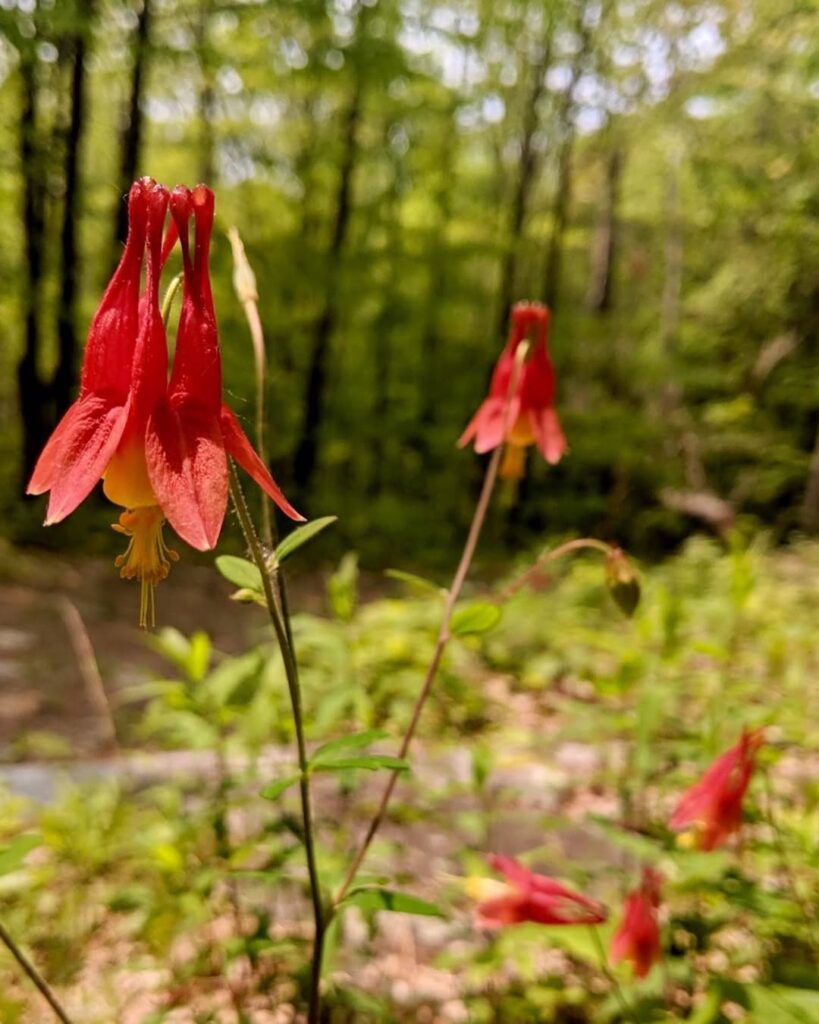
Wild Columbine (Aquilegia canadensis) is Wisconsin’s most beloved native wildflower, featuring distinctive nodding, bell-shaped blooms with red outer petals and bright yellow centers. This hardy perennial from the buttercup family grows 2-3 feet tall with delicate, fan-shaped blue-green foliage that complements its spring flower display.
Blooming from May through June, Wild Columbine thrives in challenging conditions that defeat many other perennials. It readily self-seeds to form naturalized colonies, making it perfect for woodland gardens, rocky slopes, and areas with deer pressure. The upward-pointing spurs and nectar-rich flowers attract ruby-throated hummingbirds, while its drought tolerance and adaptability to poor soils make it an excellent choice for low-maintenance landscapes. This exceptional native has earned the Royal Horticultural Society’s Award of Garden Merit for its outstanding garden performance.
- Hardiness: USDA zones 2-9, extremely cold hardy
- Light: Full sun to partial shade
- Water: Drought tolerant once established, intolerant of excessive moisture
- Soil: Well-drained, rocky or gravelly soils preferred, alkaline tolerant
- Fertilizer: None required, adapted to poor soils
- Pest/Disease Resistance: Deer resistant, generally pest and disease free
- Growth Rate: Moderate, self-seeds readily to form colonies
Wild Ginger (Asarum Canadense)
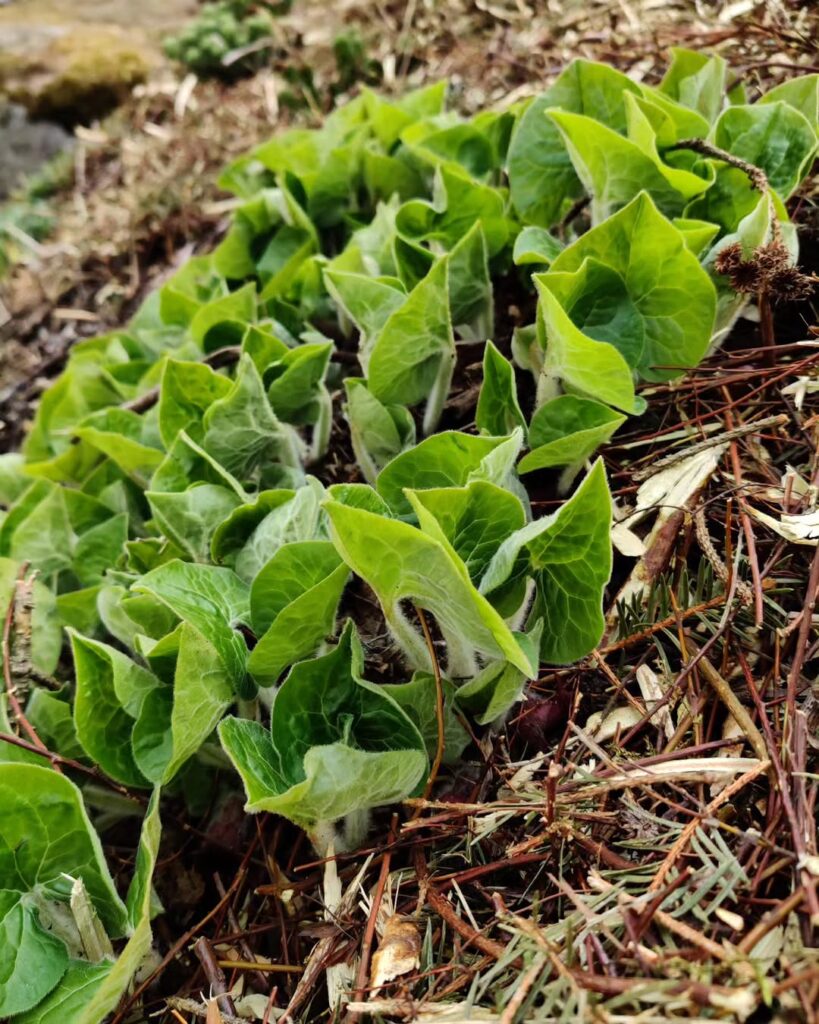
Wild Ginger (Asarum canadense) is Wisconsin’s premier native groundcover for shaded woodland areas. This low-growing perennial forms dense carpets through spreading rhizomes, reaching 8 inches tall and 18 inches wide with distinctive heart-shaped leaves. The plant produces small, hidden reddish-brown flowers from April to June that are pollinated by ants.
This hardy native thrives in Wisconsin’s climate zones 3-8 and provides reliable coverage once established. Its aromatic rhizomes were historically used by Native Americans as a ginger substitute, earning it common names like Woodland Ginger and Indian Ginger. Wild Ginger excels at preventing invasive species while complementing other native shade plants. The plant requires rich organic soil and performs best when provided with adequate moisture throughout the growing season.
- Hardiness: USDA zones 3-8
- Light: Part to full shade
- Water: Dry to medium moisture; prefers moist conditions
- Soil: Rich, moist soil preferred; tolerates clay, loam, and sand
- Fertilizer: Low maintenance; thrives in naturally rich woodland soil
- Pest/Disease Resistance: Deer resistant with good natural resistance
- Growth Rate: Moderate; transplants form solid cover in 2-3 years
Wisconsin’s Hardy Native Trees
Wisconsin’s native trees demonstrate remarkable cold tolerance and ecological value. From towering canopy species like Sugar Maple and Eastern White Pine to understory gems like Pagoda Dogwood, each offers unique benefits. The Bur Oak stands out as particularly drought tolerant, making it an excellent choice for challenging growing conditions.
Sugar Maple (Acer Saccharum)
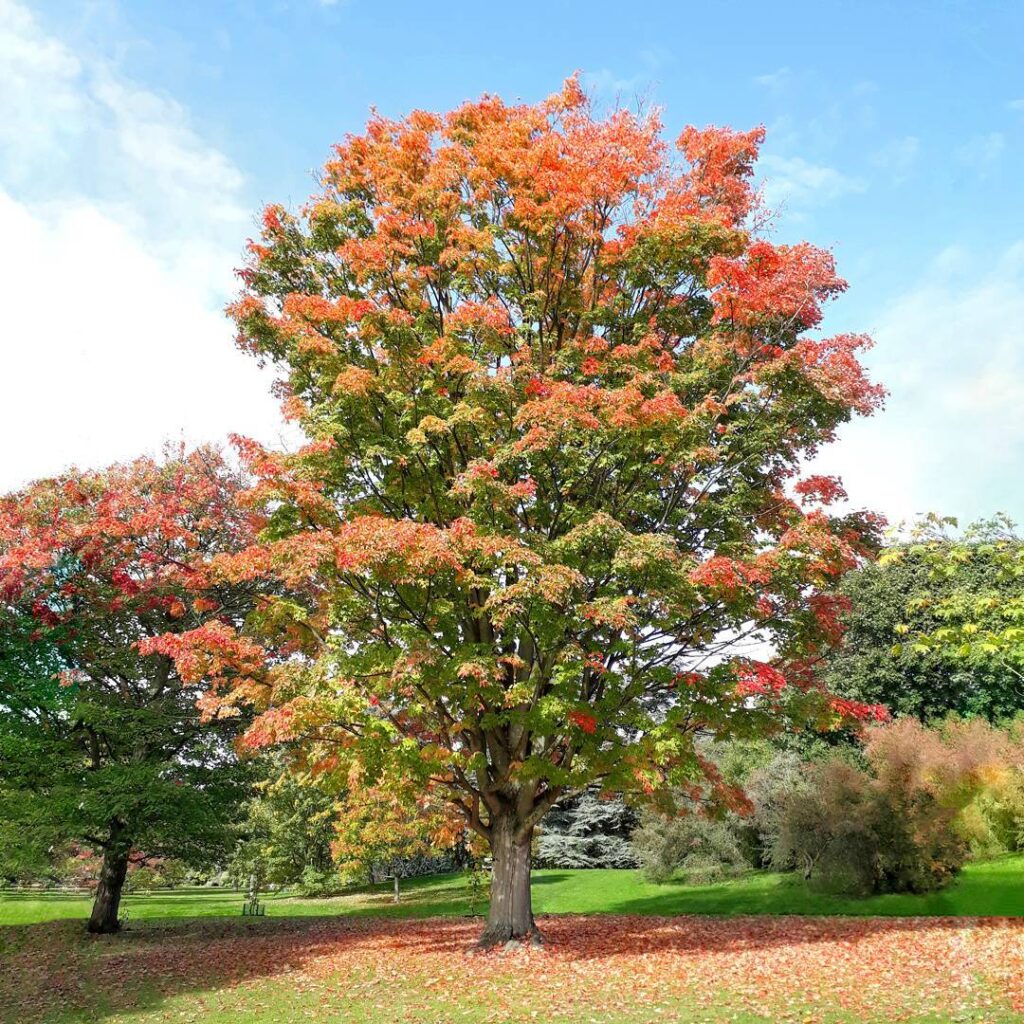
Sugar Maple (Acer saccharum) stands as Wisconsin’s official state tree and a cornerstone species of the region’s hardwood forests. This magnificent native can reach 50-75 feet in height with an impressive 50-foot spread, developing a distinctive oval crown. Renowned for its spectacular fall display of gold, orange, and scarlet foliage, sugar maple is also prized as the primary source for maple syrup production due to its high sap sugar content.
Though slow-growing, sugar maples are exceptionally long-lived, with some specimens surviving 300-400 years. They dominate Wisconsin’s upland mesic forests and represent the highest volume among all tree species in the state, accounting for 11% of total tree volume and 13% of roundwood timber production. The valuable timber is highly sought after for its strength and is commercially known as Hard Maple.
- Hardiness: USDA zones 3-8, extremely cold tolerant
- Light: Full sun to full shade; shade tolerant
- Water: Moderate moisture; prefers consistently moist but well-draining conditions
- Soil: Adaptable to pH 3.7-7.3; prefers rich, well-draining loam
- Fertilizer: Generally not needed in native soils; avoid high nitrogen
- Pest/Disease Resistance: Good overall resistance; low annual mortality rate
- Growth Rate: Slow but steady growth
American Basswood (Tilia Americana)

American Basswood is a magnificent native deciduous tree that thrives throughout Wisconsin’s hardwood forests. Reaching impressive heights of 75-130 feet at maturity, this adaptable species transforms from a conical juvenile form to a wide-spreading canopy tree. Its smooth bark evolves into distinctive furrowed ridges with age, while fragrant yellow blossoms in summer attract pollinators and make it valuable for honey production.
This shade-tolerant tree demonstrates remarkable versatility in growing conditions, performing well on both wet-mesic and dry-mesic sites. American Basswood provides essential wildlife habitat and food sources, naturally growing alongside sugar maples, oaks, and hickories. While challenging to propagate from seed, it exhibits vigorous sprouting ability that helps it compete effectively in forest regeneration. The tree’s large green leaves, which grow larger than a hand, provide dense shade making it an ideal landscape specimen.
- Hardiness: USDA Zone 3 and higher, extremely cold hardy for Wisconsin climates
- Light: Full sun to full shade, demonstrating excellent adaptability
- Water: Bimodal distribution – thrives on both wet-mesic and dry-mesic sites
- Soil: Adaptable to many soil types, performs best on deep, moist soils
- Fertilizer: Not specified, naturally thrives in rich upland forest soils
- Pest/Disease Resistance: Not specified in source material
- Growth Rate: Moderate growth rate with excellent sprouting vigor
American Elm (Ulmus Americana)

The American Elm is a majestic native tree that once dominated Wisconsin’s urban and natural landscapes. Reaching heights of 60-80 feet with its distinctive vase-shaped crown, this fast-growing deciduous tree provides exceptional shade and ecological value. Its adaptability to various soil conditions and tolerance of urban stressors made it a beloved street tree throughout the Great Lakes region.
Despite significant population decline due to Dutch elm disease, the American Elm remains an important native species for Wisconsin. Early spring brings inconspicuous flower clusters that support pollinators, followed by distinctive winged samara fruits. The tree is easily identified by its alternate, simple leaves with asymmetrical bases and doubly toothed margins. Conservation efforts focus on restoring disease-resistant native genetic stock while preserving this iconic symbol of North American forestry heritage.
- Hardiness: USDA Zone 3 and warmer
- Light: Full sun to partial shade
- Water: Prefers wet soils but adapts to various moisture levels
- Soil: Adaptable to various soil conditions; tolerates compacted urban soils
- Fertilizer: Generally not required for established trees
- Pest/Disease Resistance: Highly susceptible to Dutch elm disease; some resistant cultivars available
- Growth Rate: Fast-growing with upright, symmetrical form
Eastern Red Cedar (Juniperus)
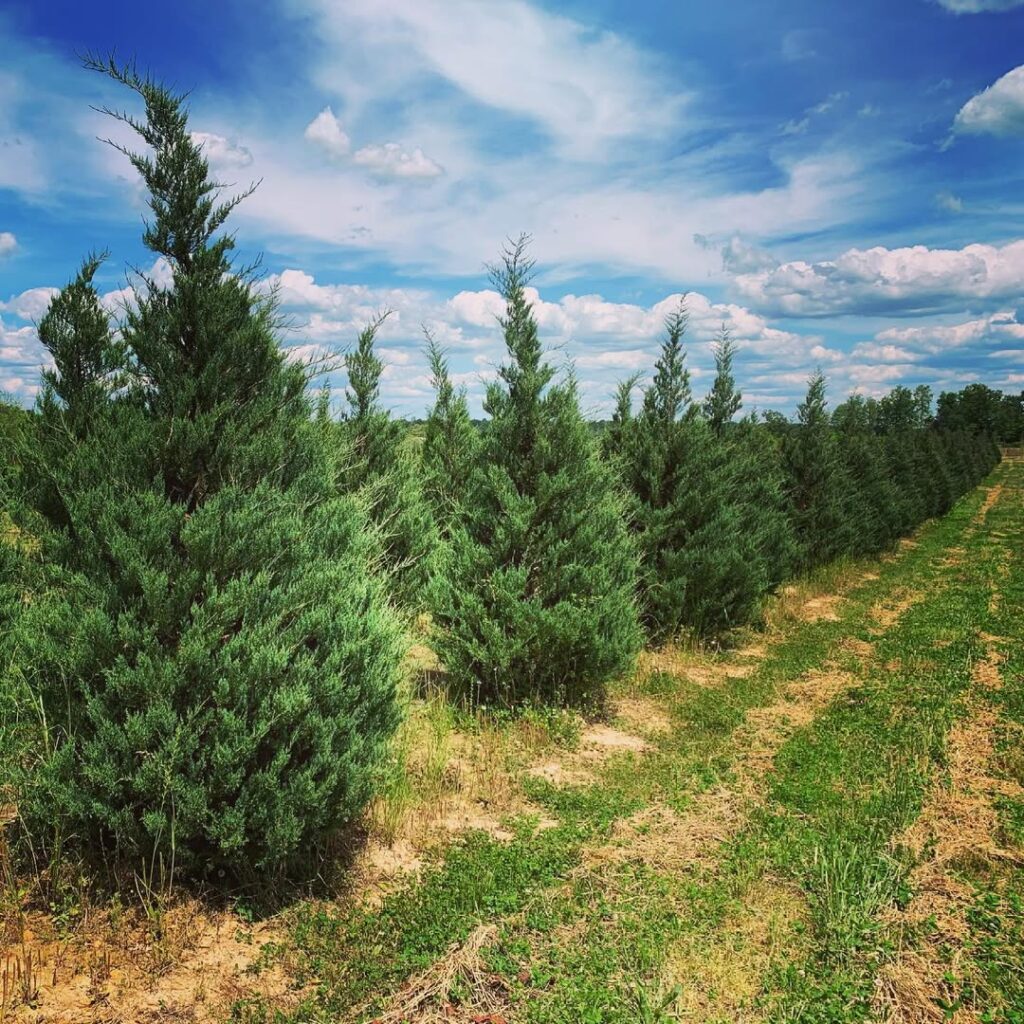
Eastern Red Cedar is Wisconsin’s most widely distributed native conifer, forming dense columnar stands along rocky bluffs throughout the state. This extremely resilient pioneer species thrives where other plants struggle, quickly establishing in abandoned fields and neglected areas. With its narrow pyramidal form reaching 30-40 feet tall and distinctive small leaves, it serves as an excellent urban-approved specimen tree and native alternative to non-native evergreens.
Notable cultivars like ‘Taylor’ and the Wisconsin-native ‘Burkii’ offer enhanced ornamental value, with Burkii featuring striking steel-blue foliage that develops purple-bronze winter coloration. While valued for its extreme hardiness and adaptability, Eastern Red Cedar requires careful site management as it can become invasive in prairie ecosystems. The tree’s reddish bark naturally exfoliates, adding year-round visual interest to the landscape.
- Hardiness: USDA Zone 3-9, extremely cold tolerant
- Light: Full sun required
- Water: Drought tolerant once established, minimal irrigation needed
- Soil: Adaptable to poor soils, rocky conditions, well-draining preferred
- Fertilizer: No fertilization required, thrives in nutrient-poor conditions
- Pest/Disease Resistance: Excellent resistance to pests and diseases
- Growth Rate: Moderate growth rate with dense branching habit
White Oak (Quercus Alba)
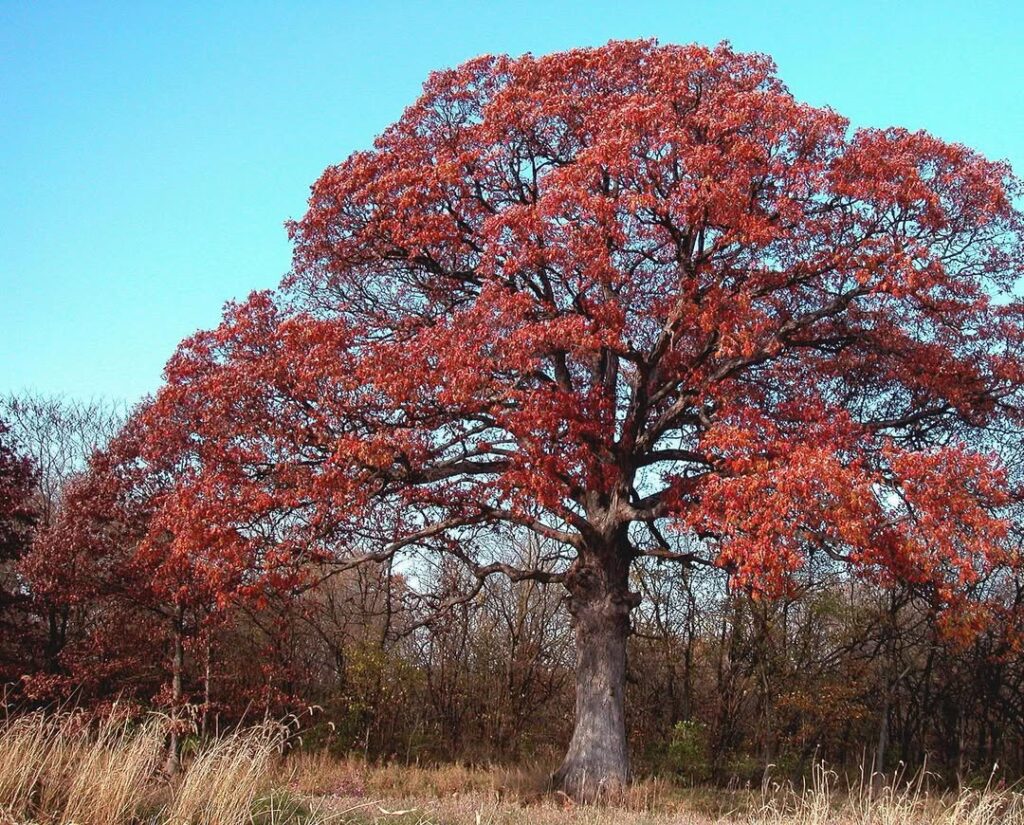
The White Oak (Quercus alba) stands as one of Wisconsin’s most magnificent native trees, maturing into an imposing specimen reaching 50-100 feet tall with an equally wide spread. This long-lived oak is distinguished by its characteristic round-lobed leaves, distinctive light ash-gray bark that appears almost white from a distance, and stunning fall colors ranging from bright red to wine red with orange and violet hues.
Young White Oaks begin with a pyramidal form before developing their iconic rounded, spreading crown with strong horizontal limbs that create a picturesque silhouette. While growth is slow but steady, this tree represents a valuable long-term investment, capable of living for centuries while providing excellent shade and serving as an important food source for wildlife through its chocolate brown acorns. The species demonstrates exceptional ecological value as a Wisconsin native and produces high-grade lumber, though it’s not recommended for urban environments due to sensitivity to soil compaction. The durable wood is highly prized for furniture, flooring, boat building, and cabinetry applications.
- Hardiness: Extremely cold hardy in Wisconsin, with southwestern Wisconsin populations showing superior winter hardiness
- Light: Full sun preferred, tolerates partial shade conditions
- Water: Moderate moisture needs; drought tolerant once established but requires adequate water during establishment
- Soil: Prefers slightly acidic, moist loamy soils but adapts to average conditions; extremely sensitive to soil compaction
- Fertilizer: Benefits from rich, well-drained soil with natural soil organisms; generous mulch ring recommended
- Pest/Disease Resistance: Generally good resistance as a native species
- Growth Rate: Slow but steady growth rate
Wisconsin’s Resilient Native Shrubs
Wisconsin’s native shrubs demonstrate remarkable cold tolerance while providing essential wildlife habitat, food sources, and year-round garden structure through harsh winters and variable growing conditions. These resilient plants offer ecological benefits that extend far beyond their visual appeal, making them invaluable additions to sustainable landscape design.
Serviceberry (Amelanchier Canadensis)
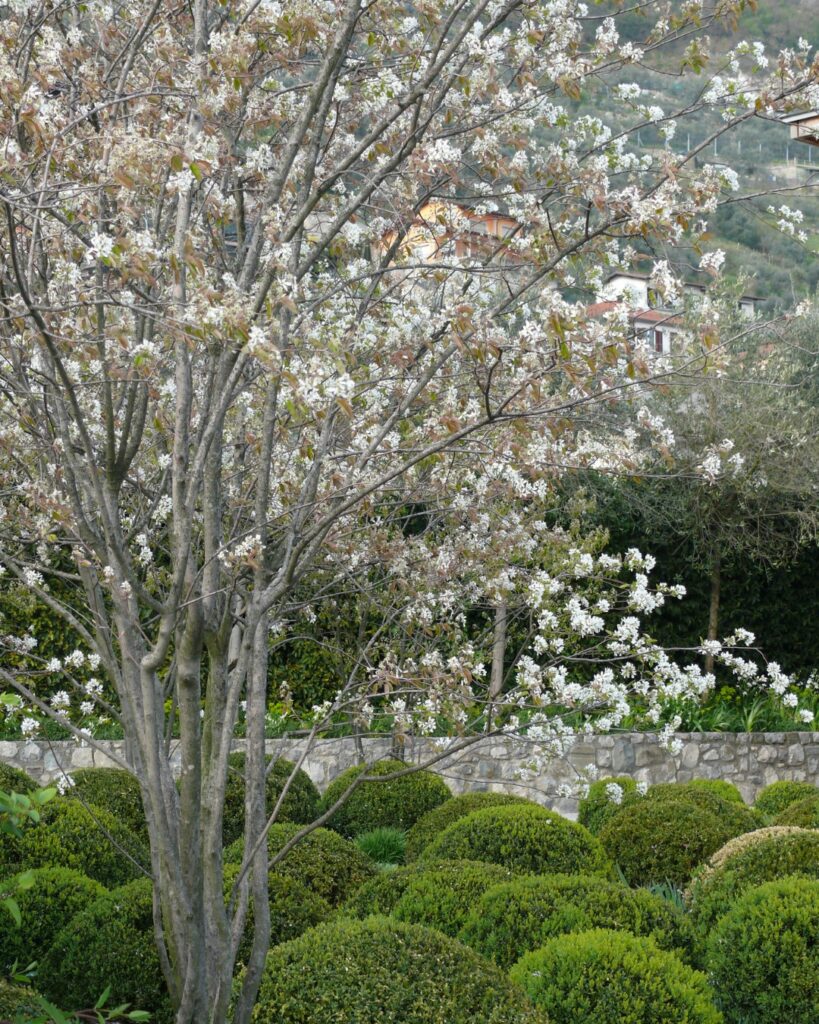
Serviceberry, also known as Juneberry, is a versatile Wisconsin native that serves as both an ornamental and ecological powerhouse. This adaptable plant can grow as a 5-10 foot shrub or develop into a 25-foot understory tree with smooth gray bark and an upright oval form.
The plant offers exceptional four-season interest, beginning with abundant white flowers in early spring before leaves emerge, followed by edible blue-purple berries in summer that attract wildlife. Fall brings stunning orange-red foliage colors, while the smooth gray bark provides winter appeal.
The tree serves as an excellent choice for bird gardens as its sweet berries attract a variety of birds and provide high nutritional value.
- Hardiness: USDA Zone 4, well-suited for Wisconsin’s climate
- Light: Full sun to partial shade
- Water: Requires consistent moisture; not drought tolerant
- Soil: Moist, well-drained loamy soil; adaptable to coarse loamy sands and sandy loams
- Fertilizer: Forms beneficial associations with mycorrhizal fungi for nutrient acquisition
- Pest/Disease Resistance: Generally resistant as a native species
- Growth Rate: Slow to moderate
Red-Osier Dogwood (Cornus Sericea)

Red-Osier Dogwood is a medium to large native shrub that exemplifies Wisconsin’s hardy plant palette. Growing 7-9 feet tall and 8-10 feet wide, this deciduous shrub forms attractive thickets through natural suckering. Its standout feature is the brilliant red winter stems that provide striking contrast against snow, while spring brings clusters of white flowers followed by bluish-white berries that feed wildlife.
This versatile shrub supports nearly 100 bird species and offers exceptional four-season interest. Fall foliage shifts from green to vibrant orange-red, then purple, while the persistent red stems maintain landscape appeal through winter months. The shrub’s suckering roots make it particularly valuable for erosion control on slopes and wet areas.
- Hardiness: USDA Zones 2-7, extremely cold tolerant
- Light: Full sun to partial shade; best stem color in full sun
- Water: Moist to wet conditions preferred; tolerates drought and flooding
- Soil: Adaptable to various soil types including clay, alkaline, and periodically flooded sites
- Fertilizer: Minimal requirements; thrives without supplemental feeding
- Pest/Disease Resistance: Generally resistant with few serious issues
- Growth Rate: Fast-growing with quick establishment
Elderberry (Sambucus Canadensis)
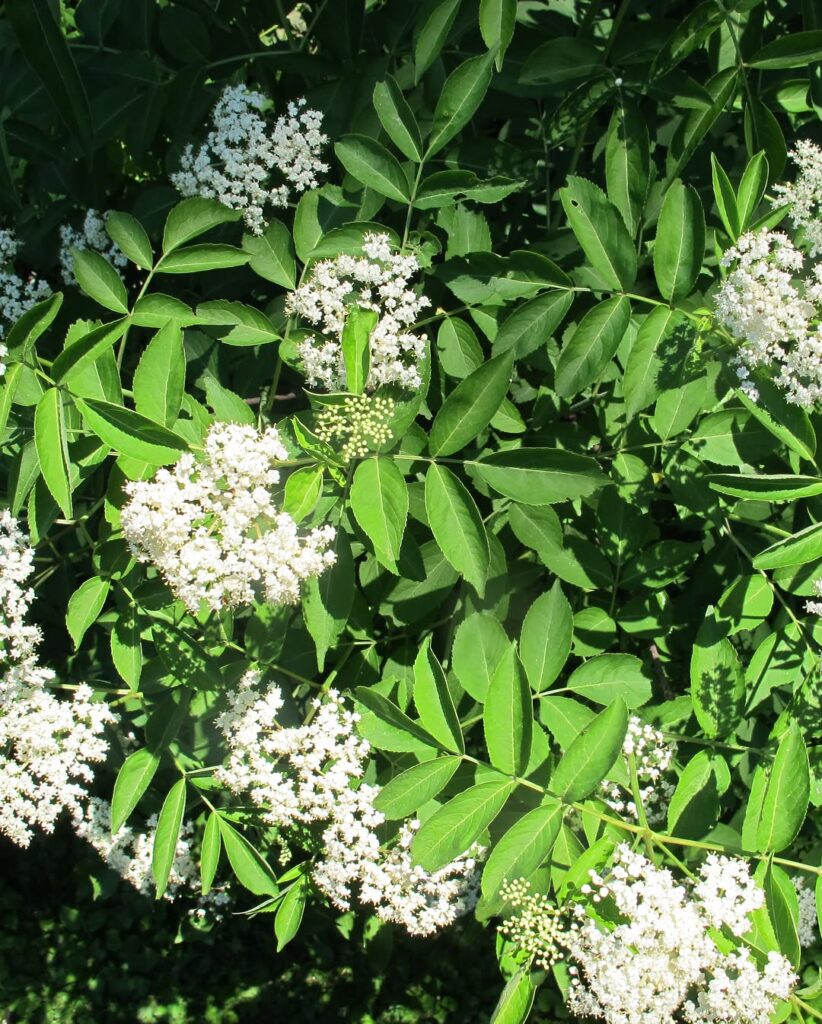
Elderberry (Sambucus canadensis) is a remarkably adaptable native Wisconsin shrub that thrives across diverse habitats from wet bogs to drier fields. This multi-stemmed deciduous shrub reaches 6-12 feet tall and wide, producing fragrant white flower clusters in summer followed by dark purple-black berries. Its suckering growth habit makes it excellent for naturalizing and erosion control along waterways.
Beyond its ecological value as a pollinator magnet and wildlife food source, elderberry offers culinary potential with cooked berries used for jams and syrups, though raw consumption should be avoided due to toxicity. The shrub’s historical significance includes traditional Indigenous uses for food, medicine, and dyes, making it both culturally important and increasingly commercially viable. The berries are consumed by over 50 species of birds and small mammals from summer through fall, making elderberry an exceptional choice for wildlife gardens.
- Hardiness: USDA Zone 4, extremely cold hardy for Wisconsin winters
- Light: Full sun to partial shade; best fruit production in full sun
- Water: Moderate to high moisture needs; tolerates wet conditions and varying moisture levels
- Soil: Adaptable to clay, loam, or sandy soils; prefers moist, well-drained conditions; acidic to neutral pH
- Fertilizer: Low requirements; thrives without supplemental feeding in native settings
- Pest/Disease Resistance: Generally resistant with few serious issues
- Growth Rate: Moderate growth rate with medium maintenance needs
American Hazelnut (Corylus Americana)
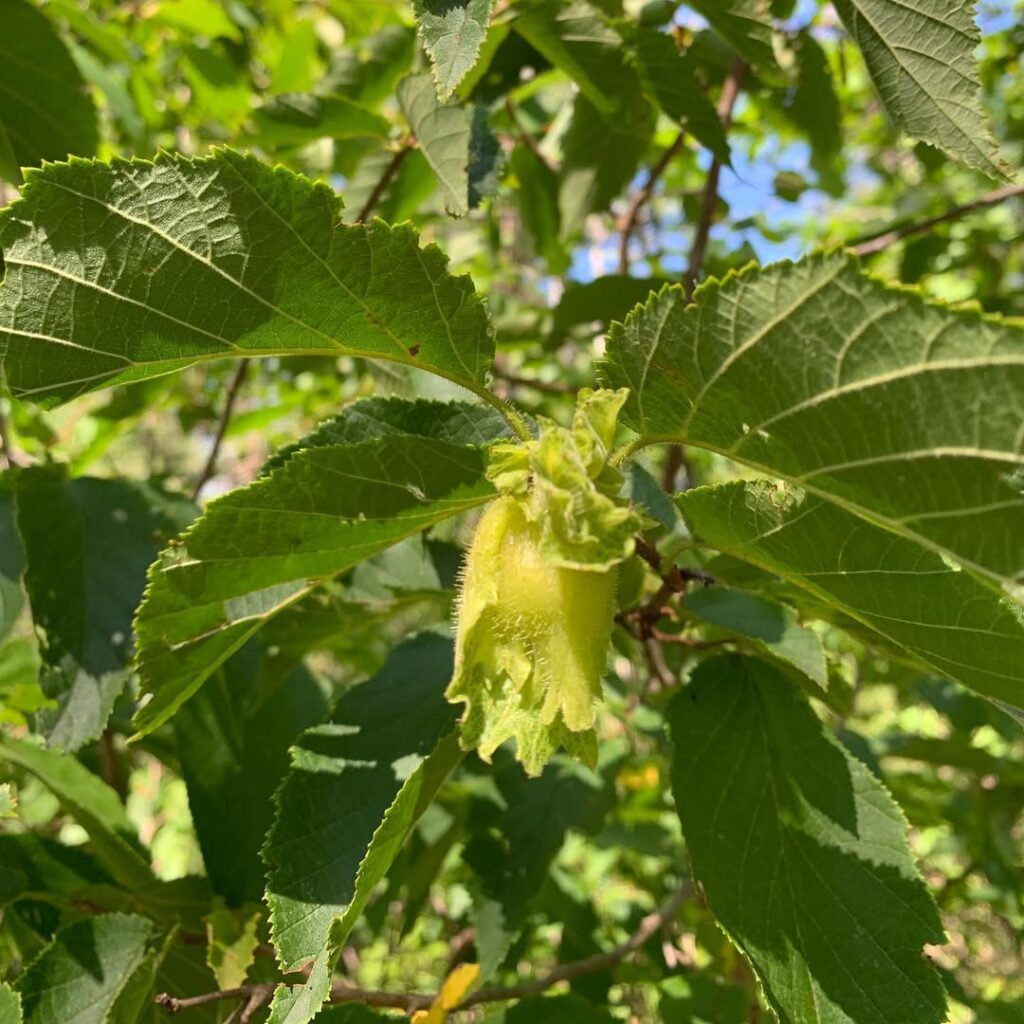
American Hazelnut (Corylus americana) is a versatile native shrub that exemplifies Wisconsin’s hardy plant heritage. Growing 6-15 feet tall, this medium to large shrub thrives across diverse conditions from prairies to woodland edges. Its dense, multi-stemmed growth creates excellent wildlife habitat while producing edible nuts that have sustained both wildlife and humans for generations.
Beyond its practical value, American Hazelnut offers year-round beauty with showy spring catkins, lush summer foliage, and vibrant fall colors. The shrub’s ability to form thickets through root suckers makes it ideal for naturalized areas, hedgerows, and restoration projects, requiring minimal maintenance once established. For optimal nut production, plant multiple shrubs together since wind pollination is most effective with several specimens in proximity.
- Hardiness: USDA zones 4-9
- Light: Full sun to partial shade
- Water: Dry to moist conditions; drought tolerant once established
- Soil: Adaptable to clay, loam, or sand; tolerates alkaline soils
- Fertilizer: Not required; thrives in native soils
- Pest/Disease Resistance: Excellent; very hardy and resilient
- Growth Rate: Fast to moderate
Ninebark (Physocarpus Opulifolius)
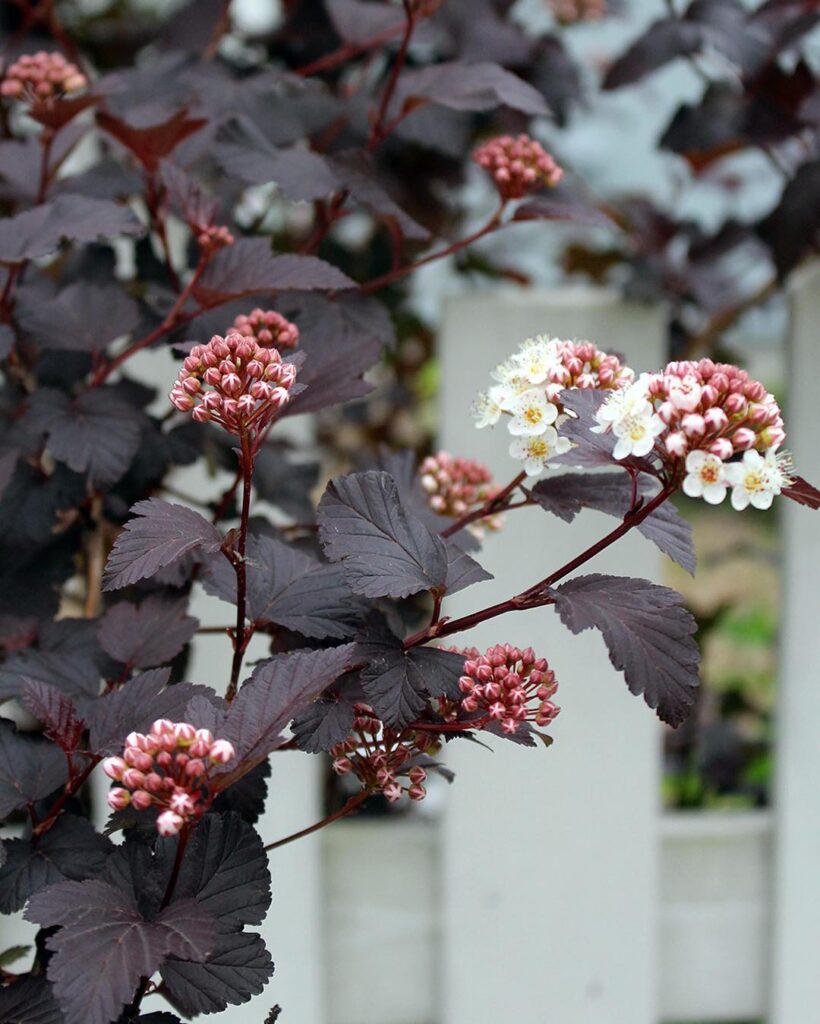
Common Ninebark (Physocarpus opulifolius) stands as one of Wisconsin’s most adaptable native shrubs, earning its distinctive name from bark that peels in strips to reveal multiple layers of reddish-brown inner bark. This mounded shrub reaches 8-10 feet in height and spread, naturally thriving on exposed cliffs and other harsh environments throughout the state.
Offering exceptional year-round interest, ninebark produces clusters of white or pink spring flowers that develop into persistent reddish-pink seed capsules. The shrub provides significant ecological value by supporting numerous moth species, offering nectar to native bees, and supplying nesting materials and shelter for songbirds. Ground-dwelling birds including turkey, quail, and pheasant also benefit from the shelter and resources this versatile shrub provides. Its extreme hardiness and tolerance of varied growing conditions make it an excellent choice for low-maintenance landscaping and erosion control.
- Hardiness: USDA Zone 2, extremely cold tolerant
- Light: Full sun to shade, highly adaptable
- Water: Dry to moist conditions, very drought tolerant once established
- Soil: Clay, loam, or sand – highly adaptable to various soil types
- Fertilizer: None required, thrives in poor soils
- Pest/Disease Resistance: Excellent, very few issues
- Growth Rate: Moderate to fast
Selecting the Right Native Plants for Your Garden
When you’re choosing native plants for your Wisconsin garden, you’ll want to start by understanding your specific property conditions and personal goals. Measure your garden space in square feet for small areas, or acres for larger projects. This helps determine how many plants you’ll need.
For effective native plant selection, follow the standard density of 50 plants per 100 square feet. Your garden design should include one tree and 2-3 shrubs, plus 72-84 grasses and sedges, along with 84-96 wildflowers and ferns. Consider your property’s location, drainage, and any height restrictions before finalizing your choices.
Native asters make excellent additions to Wisconsin gardens as these herbaceous perennial plants bloom late in the year with daisy-like flowers in colors ranging from lavender and blue to pink, purple, and white.
Frequently Asked Questions
How Do I Protect Newly Planted Native Species During Their First Winter?
You’ll need winter mulching around newly planted natives once the ground freezes. Apply 2-3 inches for plant insulation, then add pine boughs on top for extra protection against Wisconsin’s harsh conditions.
When Is the Best Time to Plant Cold Hardy Natives in Wisconsin?
You’ll have absolutely spectacular success with spring planting from March through May when soil’s perfectly moist, or fall planting from September until ground freezes when roots develop magnificently before winter dormancy.
Do Wisconsin Native Plants Require Special Soil Preparation or Amendments?
You don’t need special soil amendments for most native plants since they’ve adapted to local conditions. Focus on matching drainage requirements to your site’s moisture levels rather than adjusting soil pH or adding fertilizers.
How Much Maintenance Do Established Native Plants Need Throughout the Year?
You’ll be amazed how little work they demand! Established natives need minimal seasonal care—just occasional hand-weeding and monitoring for invasives. Their irrigation needs drop dramatically after year two, requiring water only during severe droughts.
Can Native Plants Attract Specific Wildlife Like Butterflies or Birds to My Yard?
Yes, you’ll attract specific wildlife by creating pollinator gardens with native plants. Wisconsin natives like Black Cherry trees draw 47 bird species, while native wildflowers support butterflies and bees, providing essential wildlife benefits year-round.
